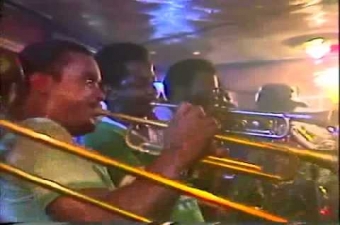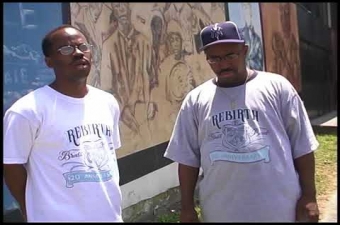The Glass House was a windowless bar in Central City about the size of a living room, filled to capacity by an eight-piece brass band, a couple dozen dancers, and a Ms. Pac Man machine. In the 1980s it was space enough to hatch a new style of brass band music, a new style of dance, and a second line renaissance.
From roughly 1980 to 1987, Monday nights here belonged to the Dirty Dozen Brass Band, a group composed of several veterans of the Fairview Baptist Church band organized by Danny Barker in 1970. (The band’s name derived from the Dirty Dozen Kazoo Band, which drummer Benny Jones paraded with; the kazoo band’s name came from the African American tradition of verbal sparring known as “the dozens.”) Their sets at the Glass House started after 11p.m., ended after 2a.m., cost $1, and came with free red beans and rice.
Drawing on the musicianship instilled by Barker and the playfulness of the Sixth Ward’s parading traditions, the Dirty Dozen became one of the most innovative brass bands of the modern era. They integrated be-bop, R&B, and whatever else they pleased into the traditional repertoire. In the footsteps of Anthony “Tuba Fats” Lacen, tuba player Kirk Joseph played heavy riffs that formed a rock solid base for dancers. The Dirty Dozen also established brass band music—traditionally played outdoors—as a nightclub attraction. Playing face-to-face with the crowd, the Dirty Dozen took cues from dancers like Sugar Slim and Ice Cream, neighborhood characters whose gymnastic moves, called buckjumping, pushed the band’s tempo.
Though it was tiny joint in a rough part of town, by the mid-80s the Glass House became a destination for visiting celebrities and intrepid music enthusiasts (among many others, David Byrne of Talking Heads was smitten). As the Dirty Dozen’s growing fame kept them on tour for weeks at a time, they handed down their residency here to the Rebirth Brass Band, one of their musical offspring.
Philip Frazier had assembled the Rebirth when he was in the Joseph S. Clark High School marching band. Seeing how the Dirty Dozen used brass band instrumentation to interpret modern music, Rebirth brought the tradition into the hip-hop era. On tuba, Frazier stripped his riffs to the bone, and hit them over and over, like a sample in a rap song. Rebirth’s style turbocharged the second line scene. As a new generation of brass bands picked it up in the 1990s, a new wave of social aid and pleasure clubs hit the streets to dance to it.
Author Jay Mazza recalled Rebirth playing the Glass House one night when the electricity went out. To keep the show going, Ajay Mallory, the snare drummer, went outside and shined his car’s headlights through the door: “The rest of the set was illuminated, and the dancers created oddly oversized shadows that raced around the room in time to the relentless Rebirth beat.” In 1990, the band recorded their album “Kickin’ It Live” here, complete with shouts from the crowd.
On Sunday afternoons the Glass House was a regular stop on second line parade routes. It also hosted Black Masking Indian practices, including those for the Creole Wild West, the oldest tribe in the city. Though the club closed in 1991, neighborhood bars from Kemp’s in Central city to Joe’s Cozy Corner in Treme started hosting weekly brass band gigs, and the second line revival rolled on.
Videos

The Dirty Dozen Brass Band performing at the Glass House in 1982, with Sugar Slim dancing in the audience.
Video posted by the Alan Lomax Archive.
The Dirty Dozen Brass Band performing at the Glass House in 1982, with Sugar Slim dancing in the audience.

The 90-minute documentary "Never a Dull Moment: 20 years of the Rebirth Brass Band" from 2003. The Glass House comes up at 34:36.
Video posted by Charlie Brown.
The 90-minute documentary "Never a Dull Moment: 20 years of the Rebirth Brass Band" from 2003. The Glass House comes up at 34:36.
Images












